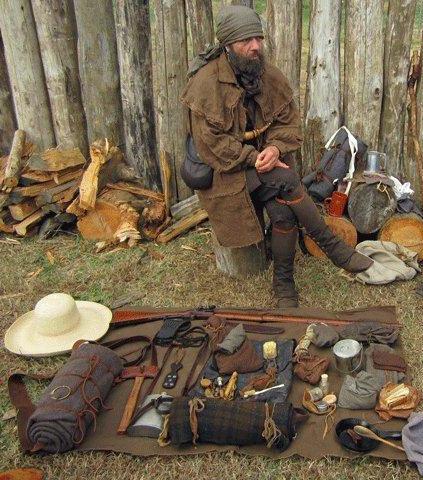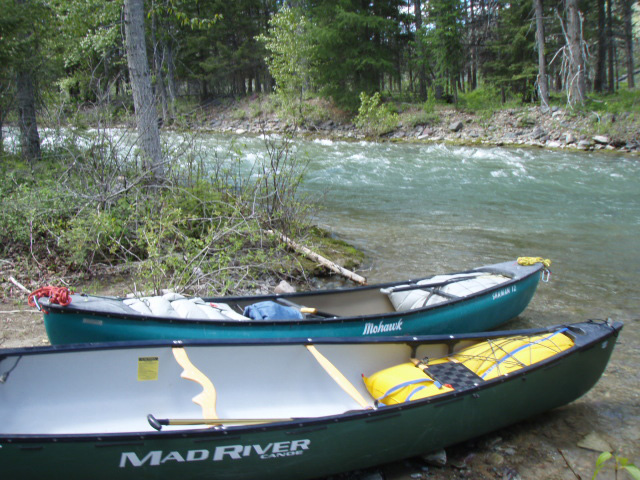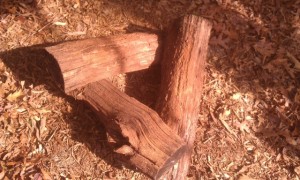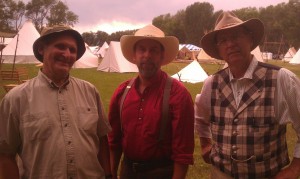Disclaimer: Although most of us here mix modern and traditional skills all the time, this article is aimed mainly at the individual with little or no knowledge regarding the use of traditional skills in conjunction with modern gear in the outdoors. Hopefully it will be helpful to those outdoor persons who happen across this site and who would like to incorporate more useful, low-impact traditional skills into their repertoire.
Today, many folks venture into the outdoors using the latest in high-tech modern gear when hunting, boating, hiking or backpacking. Many see no need for a knife and are content to do all their cooking on an ultralight gas stove. Relying completely on lightweight modern gear allows movement for long distances with low local impact while carrying a modicum of equipment, something that in the past would have been difficult for the average person to accomplish. Using ultralight modern gear is a very attractive, pleasant and effective way to travel through the woods. However, there are some traditional wilderness skills from our frontier past that are highly useful, weigh little or nothing, and which are low-impact. The further one gets from the car while on an outing, the more pertinent these skills become. Pairing relevant, traditional skills with modern gear expands its usefulness and allows one to be better prepared for certain situations that could be encountered on an extended journey outdoors.
The Knife
The knife is man’s most basic tool, and one that we should not abandon. Whether it is a pocket knife or a small sheath knife, perhaps carried in the pack, a cutting implement is an important tool in the woods. Determining the kind of knife you need, learning safe knife use, getting comfortable with using a knife, and then learning how to put that knife to work are essential outdoor skills. Its uses are many: cutting cordage to rig a tarp, preparing food, cleaning a trout, making fuzz sticks for starting fires in wet weather, removing a hard knot from a line when all else fails or whittling a replacement tent or tarp stake from downed wood are just some. Knife sharpening and care are also important related skills. Many opinions exist with regard to choosing a proper knife. Parts of many outdoor books are dedicated to this subject, so I will not attempt to identify the “perfect knife”, as no such thing exists. Educate yourself.
Fire
Fire is another traditional skill that often goes unused by the modern woods traveller; however, times could arise when building a fire quickly, safely and efficiently is essential. For instance, if one unexpectedly gets wet and chilled, it may be necessary to stop and build a fire to dry one’s self and gear before continuing. If a stove malfunctions, or if fuel is expended, it may be necessary to cook with fire, an important traditional skill in itself. It is important to learn fire safety, the best firewoods for various purposes, how to estimate temperature and how to start a fire by other than conventional means, such as when matches or lighters are rendered inoperable. All this requires prior, correct practice.
The “Survival Kit”

The basic kit takes many forms, depending on the time period (primitive, historic or contemporary). Packing for the Cherokee Campaign…Davidson’s Fort…on the North Carolina Frontier (Photo: Steve Watts)
I put this subtitle in quotations, because, again, this means many different things to many different people. For some, it might mean a knife, a pot and a way to make fire; for others, perhaps something more formal and elaborate. As much as we don’t want to think about it, survival situations happen, and they are called that for a reason. They are not a simple walk in the park, even though that might have been the original plan. Without getting into specifics, you must Be Prepared. This may require research, instruction and practice, depending on your skill level. Know the relevance of what is in your kit and how it connects to your skill level and current location on the planet. What if you break a leg twenty miles from the car? Do you have the necessary skills to splint it and manufacture a crutch or other items to aid in self-rescue? What if you lose the trail and get completely turned around? Do you know what you would do? if your day hike turns into an overnight, are you really prepared? What happens when your GPS stops working or if you are washed downstream and lose all your equipment except what is in your pockets? If necessary, get yourself some proper training, practice what you have paid to learn and read, read, read! The skills, knowledge and training necessary to help you cope with these situations are much more valuable than the extra gear you may be carrying.
Real Life
 Many years ago, on a whitewater canoe trip, we capsized our canoe with all our gear aboard. I had my survival kit in the cargo pocket of my pants. It was an elaborate kit and much more extensive than what I usually carry today. I was washed downstream. The canoe, forced downstream by the current, slammed me violently sideways into a boulder. The bag with my survival kit hit first, leaving me with a massive bruise, shattering my baseplate compass, destroying my Stormproof lighter and wetting almost everything else, including my “waterproof” matches, despite the fact that it was almost all packed into individual “waterproof” zip bags. Luckily, it was a day trip in summer and we were able to right the boat at the foot of the rapids and finish our trip without a problem. When I got back, I used the rest of the day to evaluate my gear. All of it was soaked, broken or rendered useless except for my ferrocerium fire starting rod and a couple of other items I would have probably never used anyway. If this had been a real survival situation that required fire, we would have been ok, because I knew how to use that rod. Lighting a fire with a fire-starting tool such as a ferro rod is not the same as using a lighter or match. The point is, if something is in your kit and you don’t know how to use it when the chips are down, or how to preserve it until you need it, its not much use lugging it along. Using a ferro rod requires traditional skills such as properly preparing fine kindling, as does starting and maintaing a fire for warmth or cooking. If these skills are new to someone, they require practice to learn and master, and mastery needs to occur before they are needed. Don’t listen to goofs who tell beginners that practicing useful outdoor skills at home like fire starting, tarp rigging or knot tying is useless and that you just need to “get out there” and learn, even though you don’t know what you are doing. This is a very poor and ignorant way to teach someone the ropes who might be genuinely interested (actually, it isn’t teaching at all). It’s like telling a non-swimmer to jump into the river to learn how to swim! Just as you break in boots, practice setting up a new tent at home or condition yourself physically for a long backpacking trip, traditional skills learning and practice can also be a part of your preparation. As you progress, you will probably find that you spend less and less time practicing at home or on familiar ground and more time far afield. Further, you will get more enjoyment out of your time in the woods because less of it will be spent correcting errors resulting from a lack of training. Having a tarp come down in a winter rainstorm in the middle of the night twenty miles from the nearest gravel road because one doesn’t know how to properly tie a taut-line hitch is an unnecessarily harsh way to learn. Learn first, then practice intelligently, evaluate, plan and learn from mistakes made in subsequent training and in the field.
Many years ago, on a whitewater canoe trip, we capsized our canoe with all our gear aboard. I had my survival kit in the cargo pocket of my pants. It was an elaborate kit and much more extensive than what I usually carry today. I was washed downstream. The canoe, forced downstream by the current, slammed me violently sideways into a boulder. The bag with my survival kit hit first, leaving me with a massive bruise, shattering my baseplate compass, destroying my Stormproof lighter and wetting almost everything else, including my “waterproof” matches, despite the fact that it was almost all packed into individual “waterproof” zip bags. Luckily, it was a day trip in summer and we were able to right the boat at the foot of the rapids and finish our trip without a problem. When I got back, I used the rest of the day to evaluate my gear. All of it was soaked, broken or rendered useless except for my ferrocerium fire starting rod and a couple of other items I would have probably never used anyway. If this had been a real survival situation that required fire, we would have been ok, because I knew how to use that rod. Lighting a fire with a fire-starting tool such as a ferro rod is not the same as using a lighter or match. The point is, if something is in your kit and you don’t know how to use it when the chips are down, or how to preserve it until you need it, its not much use lugging it along. Using a ferro rod requires traditional skills such as properly preparing fine kindling, as does starting and maintaing a fire for warmth or cooking. If these skills are new to someone, they require practice to learn and master, and mastery needs to occur before they are needed. Don’t listen to goofs who tell beginners that practicing useful outdoor skills at home like fire starting, tarp rigging or knot tying is useless and that you just need to “get out there” and learn, even though you don’t know what you are doing. This is a very poor and ignorant way to teach someone the ropes who might be genuinely interested (actually, it isn’t teaching at all). It’s like telling a non-swimmer to jump into the river to learn how to swim! Just as you break in boots, practice setting up a new tent at home or condition yourself physically for a long backpacking trip, traditional skills learning and practice can also be a part of your preparation. As you progress, you will probably find that you spend less and less time practicing at home or on familiar ground and more time far afield. Further, you will get more enjoyment out of your time in the woods because less of it will be spent correcting errors resulting from a lack of training. Having a tarp come down in a winter rainstorm in the middle of the night twenty miles from the nearest gravel road because one doesn’t know how to properly tie a taut-line hitch is an unnecessarily harsh way to learn. Learn first, then practice intelligently, evaluate, plan and learn from mistakes made in subsequent training and in the field.
Craft
 Learning how to make and repair things you need afield is an enjoyable part of outdoor life. As Steve Watts says, a proper pack is a bag of bags. Why not sew up a few bags to keep small pieces of kit separated that normally end up in a disorganized mess in the bottom of your pack, nearly inaccessible when you need them? Worried about the weight? Make them from modern material, like nylon! How about a traditional-style folding bucksaw, not made from ash or oak, but from a lightweight hockey stick the way Dave Wescott does it? Some “waterproof” match containers are not really waterproof. Gaskets will need to be made from bicycle inner tubes. These containers will then need to be tested. Test everything! That knife that keeps falling out needs a proper deep leather sheath. Why not carve a wooden spoon that is lightweight and low impact at the same time? How would you repair a broken pack strap? Craft adds another dimension to outdoor enjoyment. When possible, or if you desire, you may want to practice crafting (such as making tinder from natural materials) in its historical context and learn the history behind it, thus enhancing your knowledge of it and its usefulness afield.
Learning how to make and repair things you need afield is an enjoyable part of outdoor life. As Steve Watts says, a proper pack is a bag of bags. Why not sew up a few bags to keep small pieces of kit separated that normally end up in a disorganized mess in the bottom of your pack, nearly inaccessible when you need them? Worried about the weight? Make them from modern material, like nylon! How about a traditional-style folding bucksaw, not made from ash or oak, but from a lightweight hockey stick the way Dave Wescott does it? Some “waterproof” match containers are not really waterproof. Gaskets will need to be made from bicycle inner tubes. These containers will then need to be tested. Test everything! That knife that keeps falling out needs a proper deep leather sheath. Why not carve a wooden spoon that is lightweight and low impact at the same time? How would you repair a broken pack strap? Craft adds another dimension to outdoor enjoyment. When possible, or if you desire, you may want to practice crafting (such as making tinder from natural materials) in its historical context and learn the history behind it, thus enhancing your knowledge of it and its usefulness afield.
Have Fun Learning
In my experience, part of the fun of outdoor trips is planning them and then evaluating what you learn from each one. Learn, practice, then get out there and have fun!
Author Biography:
Tom Ray, 53, grew up on a small farm near Lockhart, South Carolina. His youth was spent hunting, fishing, camping and trapping in and around the Broad River Basin and Sumter National Forest. As a result, he developed a lifelong interest in history, aboriginal studies, survival, primitive arts and frontier life. Early teachers were his older brother James and his Uncle, Grover Pinkney “Pink” Scott. For the last sixteen years, he has studied with Steve Watts at the Schiele Museum of Natural History. Another very important teacher is Errett Callahan. Other teachers and influences include David Wescott, Mel Deweese, Mors Kochanski and Dave Holladay. For the past 28 years, Tom has worked in private, public and technology education. He has taught numerous primitive skills classes and has presented a multitude of interpretive programs to a wide audience. His works have been published in the Bulletin of Primitive Technology, American Frontiersman and MasterWoodsman.com. He and his wife Claudia reside in Rock Hill, SC.





7 Responses to Traditional Skills for the Modern Outdoorsman by Thomas Ray